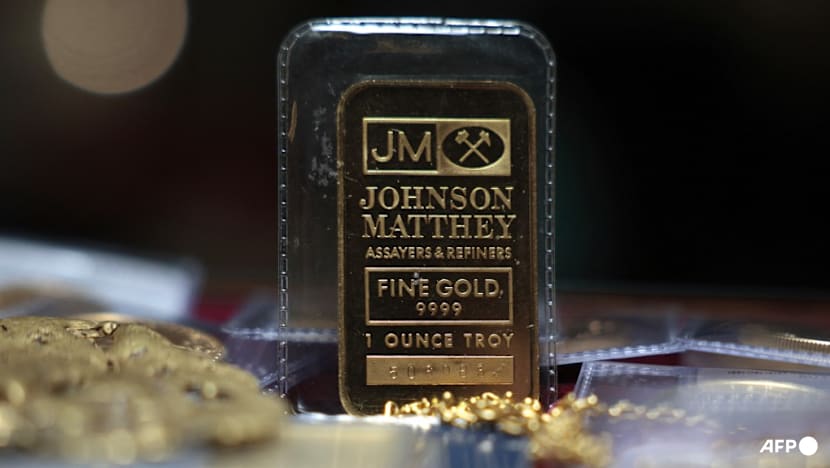US government shutdown, expected Fed cuts among reasons behind gold's record-breaking rally: Analysts
The rally has seen gold soar beyond the US$4,000 mark for the first time.

A one-ounce gold bar is displayed at a coin shop in San Francisco on Oct 7, 2025. (File photo: AFP/Getty Images/Justin Sullivan)

This audio is generated by an AI tool.
SINGAPORE: Gold surged past US$4,000 (S$5,180) an ounce for the first time on Wednesday (Oct 8) to hit a record high, as investors flocked to safe haven assets amid mounting economic and geopolitical turmoil.
Here is what five analysts had to say about the recent spike in gold prices, and how they could move in the months ahead.
A "SAFE HAVEN" IN TURBULENT TIMES
Gold has traditionally been seen as a store of value during times of instability. This is due to its predictability and reliability over the long term, said Mr Heng Koon How, the head of markets strategy at UOB.
"Gold has long proven its effectiveness as a portfolio diversifier of risk to balance returns and volatility," he said, highlighting how it is owned by central banks around the world as part of their reserves.
Mr Christopher Wong, a foreign exchange strategist at OCBC, said the recent surge in gold prices underscores the precious metal's role as both "a hedge against geopolitical stress" and a "store of value in times of policy and institutional uncertainty".
In what has been a turbulent year, gold has been among the best-performing assets, rising by more than 50 per cent year to date.
Mr Chris Weston, the head of research at Pepperstone, said that this is its "most impressive" price rise since 1979.
Analysts said that one key issue pushing investors towards gold right now is the United States government shutdown, with Mr Wong describing it as a "tailwind" for gold prices.
Most of the US government's operations ceased on Oct 1 as Republicans and Democrats failed to agree on a Bill to fund government services from October onwards.
"A look back at past episodes suggests that the duration of the shutdown can vary and the impact on asset classes may not be uniform," said Mr Wong.
During the previous shutdown, which lasted 35 days over December 2018 and January 2019, the price of gold increased by nearly 4 per cent, he added.
Mr Wong also flagged the deteriorating relations between Russia and North Atlantic Treaty Organization countries as a concern, amid dim prospects of a Russia-Ukraine ceasefire.
Political instability in France, marked by the resignation of Prime Minister Sebastien Lecornu on Monday and increasing calls for early elections, has also further heightened gold's appeal to investors, said Mr Vivek Dhar, the head of commodities and sustainability research at Commonwealth Bank.
The rally in the precious metal also comes after worries that the recent tech-driven stock market rally, which sent some equity markets to record highs, may have gone too far, fanning talk of an asset bubble.
OTHER FACTORS
Growing expectations of further interest rate cuts by the US Federal Reserve are also contributing to gold's rise.
"The Fed's rate cut in September and guidance for further cuts in 2025 (and 2026) have lowered yields, enhancing gold's attractiveness," said Mr Wong. "Gold has historically outperformed during easing cycles, reinforcing its rally."
Mr Dhar said: "The Fed fund rate cut cycle, alongside the prospect of a weaker US dollar, marks a strong cyclical tailwind for the precious metal.
"This driver emerged strongly when Federal Reserve Chair (Jerome) Powell signalled at Jackson Hole on Aug 22 that the (Federal Open Market Committee) would start cutting the Fed funds rate from September.
"Lower US interest rates increase the appeal of gold relative to US interest-bearing assets."
Gold has also benefited from a shift away from other safe haven assets that came after US President Donald Trump unveiled his "Liberation Day" tariffs, said Mr Dhar.
"The 'Liberation Day' tariffs saw gold's emergence as the preferred safe haven asset over the US dollar and US treasuries," he said.
"This marks a reordering of the safe haven assets as in previous major equity market sell-offs, like the global financial crisis in 2008 and the COVID-19 pandemic in 2020, gold typically underperformed the US dollar and US treasuries."
Listen:
While central banks are continuing to add to their gold reserves, institutions and individual investors are also fuelling the gold rally.
"Major institutions are rethinking the classic 60-40 equity-bond split, said Mr Weston.
"Morgan Stanley, for example, has proposed a 60-20-20 (equities-bonds-gold) structure.
"While gold may be tactically and technically overbought, it remains institutionally under-owned, given that global fund managers traditionally hold just a 2 per cent allocation. That appears to be changing, and we may already be seeing this reallocation into gold playing out."
Mr Heng said that one "remarkable" aspect of gold's rally over the past month is the surge in global retail investment demand for the precious metal, highlighting increased interest in gold-backed exchange-traded funds, or ETFs.
Seasonal demand, too, could be playing a role.
"Gold tends to exhibit seasonal demand patterns driven by cultural and institutional factors," said Mr Wong.
"Physical demand typically picks up around the Lunar New Year period and again between August and October, coinciding with India's wedding and festival season. On a historical basis, gold prices have tended to perform better in January, August and September.
"While (a) seasonality trend alone doesn't dictate price trends, it can reinforce upside momentum when macro conditions are supportive."
One analyst, however, said that his firm could not really attribute the rally's strength to any specific factors.
"The past two weeks' performance feels a lot like 'the trend is your friend', as we struggle to see specific reasons pushing prices up that swiftly and sharply," said Mr Carsten Menke, the head of next-generation research at Julius Baer.
"Beyond the established narratives of a slowing US economy, lower US interest rates and a weaker US dollar, which have been luring safe haven seekers into the gold market since the start of the year, the latest leg-up was further fuelled by concerns about the independence of the US Federal Reserve and the US government shutdown.
"That said, the impact of both factors on the US economy and the US dollar seems very limited, at least for now."

RALLY LIKELY TO CONTINUE
Could gold's run be indicative of a looming economic crisis? UOB's Mr Heng does not think so.
Though there is a slowdown in the US job market, he said that he does not anticipate a "full-fledged" recession either in the US or across Asia.
"In general, Asian economies have done well this year despite the sharp rise in US trade tariffs," said Mr Heng, adding that China's gross domestic product growth is also expected to stabilise at around 5 per cent.
"Overall, Asia's growing regional trade and rising domestic consumption are supportive of regional economies, and we do not see an economic recession on the horizon."
While there may be some bumps in the road ahead for gold, prices of the precious metal are expected to continue rising, said analysts.
"A short-term corrective pullback is not ruled out, especially if the US government shutdown ends quickly," said OCBC's Mr Wong.
Gold's sharp run-up in a short period of time – more than 7 per cent in two weeks – and long positions seen in Commodity Futures Trading Commission data do suggest some risks of overbought conditions, however, the structural drivers are still supportive of gold prices, he added.
Similarly, Julius Baer's Mr Menke said that the rally is underpinned by longer-term fundamentals rather than short-term speculation.
"Considering the past two weeks' price performance, speculative futures positioning has likely turned more bullish, with trend followers and technical traders entering the market in the run-up to the US$4,000-per-ounce milestone," said Mr Menke.
A halt to this record run is unlikely to come from policy tightening or improving economic prospects, he added.
"Considering that the US Federal Reserve just resumed its easing cycle, we see a very limited likelihood for such a scenario," he said.
A plausible pause may instead be attributed to "speculators' fatigue" – that all of the good news has been priced in and the latest leg of the rally is a case of "too fast, too far", he said.
"That said, such fatigue should not cause a correction but rather a short-term and temporary setback, as we still see a favourable fundamental backdrop for gold," Mr Menke added.
"The cooling US economy, paired with the prospects of lower US interest rates and a weaker US, should continue luring safe haven seekers into the market."
Mr Heng said that given "all the key long-term positive drivers" for gold and the surge in retail investment interest in it, UOB had raised its forecasts for the precious metal to US$3,900 for the fourth quarter of this year, and US$4,000, US$4,100 and US$4,200 for Q1, Q2 and Q3 of 2026, respectively.
Mr Menke, meanwhile, said that Julius Baer expects the buying of gold to continue for another three to five years, and had adjusted its three- and 12-month price targets for the commodity to US$4,150 and US$4,500, respectively.





















